|
|

  
 Programmes for: Programmes for:
 |
|
 Focus on Diarrhoea,
Dehydration & Rehydration |

|
| |
Resources for Health-care Providers
Home >
Resources > Resources for Health-care Providers
In order to provide more comprehensive and meaningful search results on
our site, several reports are available for viewing and download directly from
this web site. Kindly visit the main sites of the author organisations for more
complete and updated information.
We acknowledge our gratitude to the many people and sources whose work
has been drawn freely upon. We thank them all.
|
Training and tutorial Internet
sites for health workers
The Millennium Development Goals report 2006 [Report]

United Nations, 2006
Health Personnel and Training - regularly updated
How to evaluate an Internet-based information source [Article]
BIOME, [2005] p 7-19
 |
Breast Crawl
Initiation of Breastfeeding by Breast Crawl
visit
breastcrawl.org for video and complete dossier.
UNICEF, WHO and WABA along with the scientific community strongly
recommend initiating breastfeeding within an hour of birth.
Evidence shows that early initiation can prevent 22% of all deaths
among babies below one month in developing countries.
Every newborn, when placed on the mother’s abdomen, soon after
birth, has the ability to find its mother’s breast all on its own and
to decide when to take the first breastfeed. This is called the
‘Breast Crawl’.
This method is evidence based and has been field tested by us. A
documentary on the ‘Breast Crawl’ has been prepared for training,
advocacy and for wider dissemination. The video has created a very
high level of sensitivity among all the levels of functionaries and
was officially endorsed by senior policy makers as the right approach
for initiating breastfeeding. This dossier provides the background and
a scientific overview to the documentary.
Initiation of breastfeeding by the Breast Crawl is a critical
component of the IYCF (Infant and Young Child Feeding) initiative for
the state of Maharashtra, India. IYCF deals with nutrition of children
from birth to 3 years of age, and also takes into consideration the
nutrition of pregnant and lactating mothers. Two critical components
of IYCF are breastfeeding and complementary feeding. Improved IYCF
practices promote optimal growth and development, prevent malnutrition
and improve child survival. With 40% of the children in the state
undernourished, this initiative becomes extremely critical.
UNICEF has facilitated partnerships with all stakeholders including
the State Government, State Nutrition Mission, the Integrated Child
Development Services (ICDS), Public Health Department, BPNI
(Breastfeeding Promotion Network of India), NGOs, Community Based
Organisations (CBOs) and several academic institutions, for this major
initiative. These partnerships are aimed at creating a revolution in
the state promoting IYCF practices.
We are sure that this documentary and dossier will greatly help
similar initiatives worldwide. It is our strong desire that this
information helps every mother and baby to experience the miracle of
Breast Crawl. If we all could achieve early initiation of
breastfeeding, we will be able to prevent 22% of all deaths among
babies below 1 month.
This can be achieved by training all health care providers to initiate
breastfeeding, by Breast Crawl, to give infants the best start in
life.
visit
breastcrawl.org for video and complete dossier.
|
|
 Mother-Child Protection Card and Guide Mother-Child Protection Card and Guide
Benefiting
- Families / Program participants
- Anganwadi workers of ICDS
- Integrated Child Development Schemes
- Nurse midwife
- Supervisors of health and ICDS
This guide book is to be used as a reference book by these
functionaries of health and ICDS to focus on under three. The components
are
- Safe Motherhood
- Care of the New born
- Child Growth and Development
- Nutrition
- Immunisation and
- The Importance of the Mother Child Protection Card
Mother-Child Protection Card
|

|
Dr. R. K. Anand's Guide to Child
Care is for pregnant mothers and parents of infants, young
children, and teenagers. A definitive guide to the parent on pregnancy
and childrearing from infancy to the teenage years. Authored by one of
India's foremost paediatricians and an internationally renowned
authority on breastfeeding, the book combines a knowledge of traditional
childrearing practices with the latest medical developments in child
care.
Dr. Anand's Guide to Child Care answers questions such as:
-
Is there a right age to have a baby?
-
What can I do when my baby cries?
-
Can a working mother successfully breastfeed?
-
How helpful is a joint family in bringing up children?
-
How should we handle our fussy eater?
-
Is my child ready for toilet-training?
-
Are vaccines safe?
-
When is the right age for sex education?
-
How can I raise a happy child?
-
Are drugs overprescribed for childhood illnesses?
-
How should we handle our teenager?
-
What should I do in a medical emergency?
|

e-TALC is a
project of Teaching-aids At Low Cost (TALC),
which provides an up-to-date, authoritative source of electronic health
information for health workers in developing countries who have access to
computers but limited access to the internet.
more info
 |
Alcoholics Anonymous: The Story of How
Many Thousands of Men and Women Have Recovered from Alcoholism
Online Versions:
aa.org
| anonpress.org
It's more than a book. It's a way of life. Alcoholics Anonymous-the Big
Book-has served as a lifeline to millions worldwide. First published in
1939, Alcoholics Anonymous sets forth cornerstone concepts of recovery
from alcoholism and tells the stories of men and women who have overcome
the disease. With publication of the second edition in 1955, the third
edition in 1976, and now the fourth edition in 2001, the essential
recovery text has remained unchanged while personal stories have been
added to reflect the growing and diverse fellowship. The long-awaited
fourth edition features 24 new personal stories of recovery. Key features
and benefits ·the most widely used resource for millions of individuals
in recovery ·contains full, original text describing AA program ·updated
with 24 new personal stories
About the Author
Alcoholics Anonymous (AA) is an informal meeting society for recovering
alcoholics whose primary purpose is to stay sober and help other
alcoholics achieve sobriety.AA suggests that alcoholics follow its
program and abstain from alcohol in order to recover from alcoholism, and
share their experience, strength, and hope with each other that they may
solve their common problem.AA was the first twelve-step program and has
been the model for similar recovery groups like Narcotics Anonymous.
Al-Anon/Alateen are programs designed to provide support for relatives
and friends of alcoholics. The organization was named after its primary
guidebook Alcoholics Anonymous, also known as The Big Book. Although AA
is not for everyone, there is growing evidence supporting the
effectiveness of AA as a treatment for alcoholism.
575 pages - Alcoholics Anonymous World Services; 4 Revised edition
(February 10, 2002) - English
ISBN-10: 1893007162, ISBN-13: 978-1893007161 |
|

click to enlarge
|
Knowledge and Use of Oral Rehydration
Therapy for Childhood Diarrhoea in India: Effects of Exposure to Mass Media
Results from these two studies indicate that, despite a vigorous
Oral Rehydration Therapy Programme in India for more than a decade,
knowledge and use of ORT to treat childhood diarrhoea remain quite limited.
Very small percentages of children who fall sick with diarrhoea are treated
with oral rehydration salt (ORS) packets, recommended home solution (RHS),
or increased fluids, despite the fact that 61 percent of these children
receive treatment from a health facility or provider. In the NFHS, among
children born 1-47 months before the survey who had diarrhoea in the last
two weeks, 18 percent were given ORS and 19 percent were given RHS.
Considered together, only 31 percent were given ORS or RHS.
Among those who receive treatment from a health facility or provider, a very
large proportion (94 percent) are treated with antibiotics or other
antidiarrhoeal drugs, contrary to WHO recommendations that drugs not be used
to treat diarrhoea in young children. The use of drugs is common among both
public- and private-sector providers but is more common in the private
sector.
The analysis indicates that the electronic mass media are effective in
increasing awareness and use of ORT. Women regularly exposed to the media
are much more likely than unexposed women to know about ORS packets and to
use ORS or RHS. This result is valid even after controlling for the effects
of a number of potentially confounding variables by holding them constant.
Results also indicate some discrimination against girls in the use of ORS.
These findings suggest that both mothers and health-care providers are not
well informed about the proper treatment of childhood diarrhoea. There is
clearly a need to strengthen education programmes for mothers and to provide
supplemental training to health-care providers, emphasizing the importance
of increased fluid intake and discouraging the use of unnecessary and often
harmful drugs. The Oral Rehydration Therapy Programme also needs to address
the problem of gender discrimination in the treatment of diarrhoea. In all
these efforts, the mass media can help.
Audience:
K.V. Rao, Vinod K. Mishra, and Robert D. Hetherford
National Family Health Survey Subject Reports
Number 10 - November 1998
55 pages -
 pdf 160 kb
pdf 160 kb |
|

click to enlarge
|
Gender Differences in Treatment-seeking
Behaviour during Common Childhood Illnesses in India: Does Maternal
Education Matter?
Gender inequalities, in one form or the other, with considerable
contextual differences, are ubiquitous and all-pervasive in South Asia. In
health, these are manifested in differences in mortality (observed by
overall sex-ratio) in almost every country in this region. India is no
exception in this regard. Discrimination and gender gaps have been observed
even in early years of life. Beside other factors, discriminatory
treatment-seeking practices among children during the post-neonatal and
later childhood period probably contribute to this.
There are numerous studies which have established the positive effect of
maternal education on child health and survival. But there are contradictory
evidences that whether maternal education reduces gender bias in
treatment-seeking behaviour or not and the debate over it remains
inconclusive.
By using National Family and Health Survey (NFHS-2), 1998-99, the present
study observed that the gender bias in treatment seeking behaviour does
exist among illiterate and middle school educated women when child is
affected by acute respiratory infections and reduces considerably among
higher educated mother.
In case of diarrhoea no evidence of gender differences in treatment seeking
behaviour has been found statistically irrespective of the level of maternal
education, even after controlling all other spatial, demographic and
socioeconomic factors.
Audience:
Saswata Ghosh
Research Scholar, Centre for the Study of Regional Development, School of
Social Sciences, Jawaharlal Nehru University, New Delhi India.
18th European Conference on Modern South Asian Studies
University of Lund, Sweden
6-9 July, 2004
National Family Health Survey Subject Reports
Number 10 - November 1998
17 pages -
 pdf 193 kb
pdf 193 kb |
Maharashtra, India
Human Development
Reports
Maharashtra State
- Waterborne Diseases Epidemic Information
For the last 10 years - as at 20 March 2004
Maharashtra State - ORS
Supply Information
For the last 10 years - as at 20 March 2004
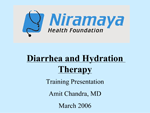 |
Diarrhea and Hydration Therapy
Training Presentation - Amit Chandra, MD - March 2006 - 25 slides
Niramaya Health Foundation
Presentation:
flash
433 kb. |
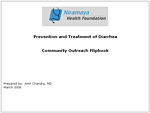 |
Prevention and Treatment of Diarrhea
Community Outreach Flipbook
Prepared by: Amit Chandra, MD - March 2006
Niramaya Health Foundation |
|
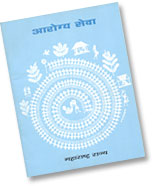
click to
enlarge
|
Maharashtra State - Health Status
in Marathi
Audience:
2002
67 pages -
 pdf 2 mb pdf 2 mb
|
|

|
Health and Healthcare in Maharashtra
A Status Report - 2005
Maharashtra has been in the forefront of healthcare development in the
country. It was among the first states to decentralize primary healthcare
administration through Zilla Parishads as early as1961. Further, under the
Minimum Needs Program Maharashtra was again one of the first states to
achieve the norms mandated for primary health centres, subcentres and
Rural Hospitals. The state also has the largest private health sector in
India whose reach is quite extensive.
While Maharashtra is today also the most affluent state in the country
with the highest per capita income, and contributes over 15% of the
country’s national income and 40% of the tax revenues, it continues to
have high levels of poverty and inequalities which get reflected in health
outcomes which are not the best in the country. Thus Maharashtra has to
still struggle with malnutrition deaths, child mortality and maternal
mortality levels not commensurate with its economic position in the
country, declining child sex-ratios, low and declining levels of public
health spending and investments, high levels of vacant positions of
doctors at PHCs and CHCs, and low levels of access to various health
services like antenatal care, complete child immunization, institutional
deliveries etc.
81 pages -
 pdf
1.5 mb pdf
1.5 mb
|
Guides
|
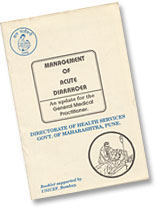
click to enlarge
|
Management of Acute Diarrhoea
An update for the General Medical Practitioner
Audience:
Directorate of Health Services, Govt. of Maharashtra, Pune
Booklet supported by UNICEF, Bombay
16 pages -
 pdf 456 kb pdf 456 kb |
|

click to enlarge
|
Diarrhoea - Guide 3
Audience:
Govt. of India, Central Health Education Bureau, Ministry of health and
Family Welfare
May 1984
8 pages -
 pdf 2.5 mb pdf 2.5 mb |
|

click to enlarge
|
Marathi Cookbook
Iron and Vitamin C Rich Recipes
Gharchya Ghari Anaemia Tala
Audience:
June 2002
67 pages -
 pdf 2.8 mb pdf 2.8 mb |
|

click to enlarge
|
Developing an Alternative Strategy for
Achieving Health for All
The ICSSR/ICMR Model - The FRCH Experience
Audience:
Noshir Antia, Seema Deodhar, Nerges Mistry
Foundation for Research in Community Health, Pune / Mumbai
2004
52 pages -
 pdf 844 kb pdf 844 kb |
|

click to
enlarge
|
Management of Critically Sick Child
Audience:
Directorate of Health Services Maharashtra State
Department of Paediatrics, Cama & Albless Hospital, Mumbai
Maharashtra State Health Education Bureau, Aundh, Pune
1997-1998
41 pages -
 pdf 9.5 mb pdf 9.5 mb |
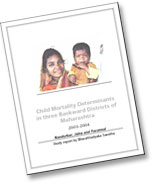 |
Child Mortality Determinants in three
Backward Districts of Maharashtra
Nandurbar, Jalna and Yavatmal
2003-2004
By Shyam Ashtekar, Dhruv Mankad, Kranti Raimane
BharatVaidyak Sanstha, NASIK
Courtesy of Indira Gandhi Institute of Development Research, Mumbai,
India
January 2004
An array of factors-some antecedents and some determinants --
interplay to cause child deaths directly or indirectly. We can
understand them as sectors--social sector, environment, health system
etc. Each sector is amenable to different interventions and our main
effort here is to see what can be done through the health system to
improve child survival. This does not mean that other sectors are less
important, in fact they can be more important and economical for
interventions, but there are separate reports on these sectors. It is
needless to stress that the sectors overlap and intermingle and the
accompanying figure only serves to bring clarity in approach.
Our team of 3 researchers studied Child mortality and its determinants
in three low HDI districts of Maharashtra--Nandurbar, Yavatmal, and
Jalna. The study used secondary data, mainly MIS report and
qualitative methods for direct inquiry. The study was undertaken in
Sept 2003. Interviews with district health staff, PHC MOs, LHVs, ANM,
TBAs, AWWs, PMPs, families, NGOs and RH doctors were conducted with
help of semi-structured questionnaires.
111 pages -
 pdf 1.3 mb pdf 1.3 mb |
Posters
India
|
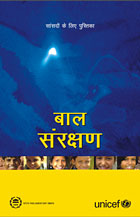
|
Child Protection: A Handbook for
Parliamentarians
Audience: Parliamentarians
UNICEF India
2005
Hindi 182 pages -
 pdf 2.4 mb pdf 2.4 mb |
|
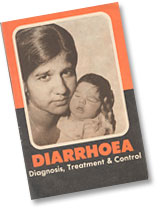
click to enlarge
|
Diarrhoea - Diagnosis, Treatment & Control
Audience:
Directorate General of Health Services, Government of India, New Delhi
Central Health Education Bureau, Ministry of Health & Family Welfare
April 1985
16 pages -
 pdf 2.3 mb pdf 2.3 mb |
|

click to enlarge
|
Training of Doctors on Nutritional Care
During Diarrhoea
Audience:
National Diarrhoeal Diseases Control & O.R.T. Programmes
Government of India, Directorate General of Health Services, Ministry of
Health and Family Welfare, New Delhi, India
prepared by the
National Institute of Cholera and Enteric Diseases (ICMR) Calcutta, India
15 pages -
 pdf 780 kb pdf 780 kb |
|

click to enlarge
|
The Management of Diarrhoea and Use of Oral
Rehydration Therapy - Second Edition - A Joint WHO/UNICEF Statement
Audience:
prepared by WHO/UNICEF
1992
30 pages -
 pdf 626 kb pdf 626 kb |
|

click to enlarge
|
National Guidelines on Infant and Young
Child Feeding
Audience:
Ministry of Human Resource Development, Department of Women and Child
Development, Food and Nutrition Board, Government of India
August 2004
37 pages -
 pdf 936 kb pdf 936 kb |
|

click to
enlarge
|
National Guidelines on Infant Feeding
Audience:
Food and Nutrition Board, Department of Women and Child Development,
Ministry of Human Resources Development, Government of India.
1992
17 pages -
 pdf 2.5 mb pdf 2.5 mb |
|

click to
enlarge
|
Policy on Control of Nutritional Anaemia
Audience:
Ministry of Health & Family Welfare, Government of India
January 1991
11 pages -
 pdf 1.7 mb pdf 1.7 mb |
|

click to enlarge
|
Prevention and Control of Nutritional
Anaemia: A South Asia Priority
Audience:
United Nations Children's Fund - Regional Office for South Asia
2002
16 pages -
 pdf 2 mb pdf 2 mb |
|

click to enlarge
|
Preventing and Controlling Iron Deficiency
Anaemia Through Primary Health Care
Audience: A Guide for Health Administrators and Programme Managers
E. M. DeMaeyer
Formerly Medical Officer, Nutrition, World Health Organization,
Geneva, Switzerland
with the collaboration of
P. Dallman, J. M. Gurney, L. Hallberg, S. K. Sood & S. G. Srikantia
1989
61 pages -
 pdf 1.7 mb pdf 1.7 mb |
|

click to enlarge
|
Measles Control: An Urban Challenge
Audience:
National Immunization Programme, Government of India
1998
32 pages -
 pdf 4.3 mb pdf 4.3 mb |
|

|
Sahyogini
Animator to guide Self Help Groups
Audience:
All NGOs, Institutes and Persons working in the Self Help Group Movement.
Abstract:
This book is based on the experiences and achievements of the Maharashtra
Rural Credit Programme. Sahyogini (Animator) is the back bone of this
programme working in the villages with the Self Help Group to Guide & Help
them by providing technical support. This book is focused on the working
procedure of the Self Help Group Dynamics, Formation, Structure, working
procedure etc. This guide answers frequently asked questions.
41 pages -
 pdf 3 mb pdf 3 mb |
|

|
Mahilanche Hakk Anni Adhikar
Women's Rights & Laws
Audience:
All NGOs, Institutes and Persons working in the women empowerment and
Development.
Abstract:
This book is published by Women’s Development Cooperation (Mavim), a
Government of Maharashtra undertaking. This book tries to focus on the
Government Resolutions issued by the Government of Maharashtra and on the
various aspects of laws related to women and the rights provided to her.
This book highlights objectives of the Government resolution and about the
Acts. Basic things all should know about legal and judicial system. Its
Objective, Protection for women under the Acts, how the Act can be a useful
for a women etc are presented in the books.
This book is the guideline for the field worker circulated along with the
video film.
59 pages -
 pdf 6.6 mb pdf 6.6 mb |
Vitamin A: Frequently Asked Questions - English
Vitamin A:
Frequently Asked Questions - Marathi -
 pdf 49 kb pdf 49 kb
Vitamin A Marathi brochure -
 pdf 470 kb pdf 470 kb
WHO Reproductive Health Publications
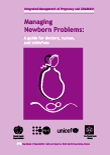 Managing
newborn problems: A guide for doctors, nurses and midwives Managing
newborn problems: A guide for doctors, nurses and midwivesThis
guide, based on the latest available evidence, provides up-to-date,
authoritative clinical guidelines that are relevant to a facility with
basic laboratory facilities, selected essential drugs and supplies, and
the capability to provide safe blood transfusion. In some settings, the
guide will be relevant to large health centres that provide childbirth
care and have the capacity to care for sick or small newborn babies.
More
information/full text |
|
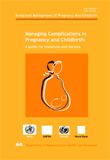 Managing
complications in pregnancy and childbirth Managing
complications in pregnancy and childbirth
A must for midwives and doctors at the
district hospital who are responsible for the care of women with
complications of pregnancy, childbirth or the immediate postpartum
period, including immediate problems of the newborn. Both physicians and
midwives will find this manual essential for promoting and assessing the
quality of health services, in the training of providers and in
supporting quality services through supervision and performance
feed-back.
More
information/full text
Español
-
Français |
|
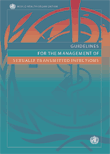 Guidelines
for the management of sexually transmitted infections Guidelines
for the management of sexually transmitted infections
Sexually transmitted infections (STIs)
remain a public health problem of major signifi cance in most parts of
the world. The incidence of acute STIs is believed to be high in many
countries. Failure to diagnose and treat STIs at an early stage may
result in serious complications and sequelae, including infertility,
fetal wastage, ectopic pregnancy, anogental cancer and premature death,
as well as neonatal and infant infections. The individual and national
expenditure on STI care can be substantial.
More
information/full text
Español -
Français -
Portuguese |
National Family Health
Survey, India 1998-1999 (NFHS-2)
A large-scale National Family Health Survey (NFHS) in most of larger states
and National Capital Territory of Delhi in 1992-1993. The repeated survey
NFHS-2, 1998-1999. Both have focus on fertility and child mortality, family
planning and health. NFHS 2 was funded by USAID through ORC Macro and UNICEF.
Clinical Management of Acute
Diarrhoea - WHO/UNICEF Joint Statement
 pdf 348 kb pdf 348 kb
Consensus Statement of IAP
National Task Force: Status Report on Management of Acute Diarrhea
 pdf 376 kb pdf 376 kb
Census India - 2001
Rural - Urban distribution of population - India and states/Union territories
Demographics and Health
Surveys [DHS] - India Publications
India Country Statistics - Indicators 1992/93 & 1998/99
Review of National Immunization Coverage 1980-2002, India
WHO/UNICEF - October, 2003
13 pages -
 pdf 125 kb pdf 125 kb
The Free And Compulsory Education Bill, 2004
- India
A Bill to provide free and compulsory education to all children from the age
of six to fourteen years.
Centers for Disease Control & Prevention CDC Related Resources
 |
Health and Healing is for first contact or primary health
care workers. It is about both health and healing at the primary
level. It offers a broad and comprehensive range of health topics
from personal health to national health programmes, from
system-wise illnesses to health problems of at-risk groups like
women, children and old persons. By Dr. Shyam Ashtekar |
Off-site links
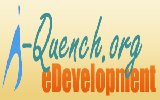 |
i-Quench.org/eDevelopment is a recent web portal dedicated to
exploring new and emerging ICTs for development in India in the areas of
health, education, poverty alleviation, agriculture, micro-finance,
e-governance, trade of goods and services, market-based information
dissemination - all leading to ICTs-supported holistic community
development. |
|
The Nutrition
Transition Is Underway in India
Paula L. Griffiths, Margaret E. Bentley
Nutrition research in India has previously focused on the serious problem of
undernutrition related to nutrient deficit and high rates of infection. Recent
data from the National Family Health Survey 1998/99 (NFHS 2), however,
identified a significant proportion of Indian women as overweight, coexisting
with high rates of malnutrition. This paper examines the emerging nutrition
transition for women living in rural and urban communities of Andhra Pradesh,
India. NFHS 2 provides nationally representative data on women’s weight and
height. In this paper, we examine representative data from the state of Andhra
Pradesh (n = 4032 women). Logistic regression analyses are applied to the
data to identify socioeconomic, regional and demographic determinants of
overweight and thinness. The major nutrition problem facing women continues to
be undernutrition, with 37% having a low body mass index [(BMI) < 18.5 kg/m2];
8% of these women are severely malnourished (BMI < 16 kg/m2).
However, 12% of the women can be classified as overweight (BMI > 25 kg/m2)
and 2% are obese (BMI > 30 kg/m2). Furthermore, in the large cities
of the state in which 4% of the sample live, 37% of women are overweight or
obese, whereas in the rural areas in which 74% reside, 43% have a low BMI. Women
from lower socioeconomic groups are also significantly more likely to have a low
BMI. Findings from the logistic regression models reveal socioeconomic status to
be a more important predictor of both over- and underweight than location of
residence.
|
India -
The Free and Compulsory Education Bill, 2004
Women's Health Links
Online Booklets:
Abortion |
Cervical smears |
DES |
Fibroids |
Heavy bleeding |
HPV & genital warts |
HRT |
Hysterectomy
Know your menstrual cycle |
Natural menopause |
Ovarian problems |
PID |
PMS |
Prolapse |
Thrush |
Vulval pain & discomfort
The links listed here are links to websites containing
information on women's health issues which we think our visitors may find of
interest. Inclusion on this page does not constitute an endorsement of the
advice or services provided through these sites.
Free Downloads from Hesperian
Hesperian
Home >
Publications and Resources >
Downloads
Hesperian has made a commitment to publish online versions of all of our
books and to keep those online editions up-to-date, incorporating all
corrections and revisions as they are made.
Presently we have materials from the following publications:
Where There Is No
Doctor
Where Women Have No
Doctor
A Book for Midwives
HIV Health and Your
Community
Helping Children Who
Are Deaf
<a title="A fa |